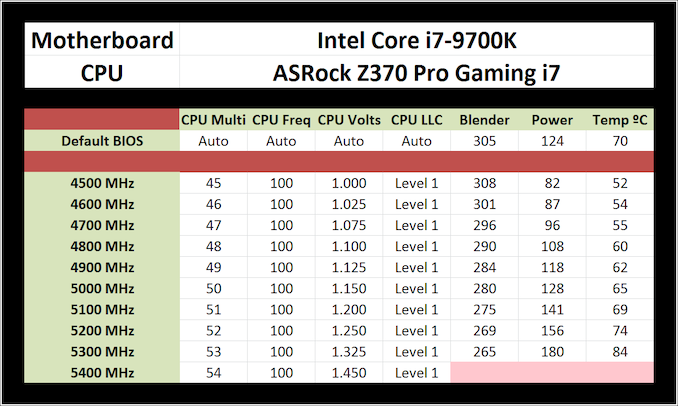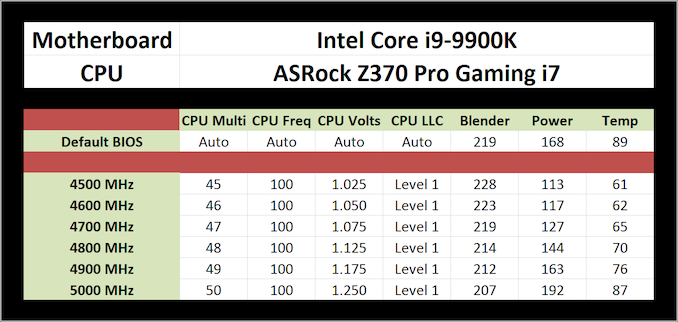The Intel 9th Gen Review: Core i9-9900K, Core i7-9700K and Core i5-9600K Tested
by Ian Cutress on October 19, 2018 9:00 AM EST- Posted in
- CPUs
- Intel
- Coffee Lake
- 14++
- Core 9th Gen
- Core-S
- i9-9900K
- i7-9700K
- i5-9600K
Overclocking
With the upgraded thermal interface between the processor and the heatspreader, from paste to solder, Intel is leaning on the fact that these overclockable processors should be more overclockable than previous generations. We’ve only had time to test the Core i9-9900K and i7-9700K on this, so we took them for a spin.
Our overclocking methodology is simple. We set the Load Line Calibration to static (or level 1 for this ASRock Z370 motherboard), set the frequency to 4.5 GHz, the voltage to 1.000 volts, and run our tests. If successfully stable, we record the power and performance, and then increase the CPU multiplier. If the system fails, we increase the voltage by +0.025 volts. The overclocking ends when the temperatures get too high (85C+).
For our new test suite comes new overclocking features. As mentioned in the previous page, our software loading for power measurement is POV-Ray, which can thrash a processor quite harshly. POV-Ray also does a good job on stability, but is not a substantial enough test – for that we use our Blender workload, which pushes the cores and the memory, and lasts about 5 minutes on an 8 core processor.
Results as follows:
For the Core i7-9700K, we hit 5.3 GHz very easily, for a small bump in power and temperature. For 5.4 GHz, we could boot into the operating system but it was in no way stable – we were ultimately voltage/temperature limited at this case. But an eight core, eight thread 5.3 GHz CPU at 180W for $374? Almost unimaginable a year ago.
Overclocking the Core i9-9900K was not as fruitful. The best bit about this overclock is the 4.7 GHz value: by using our own voltage settings, we reduced power consumption by 41W, almost 25% of the total power, and also reduced temperatures by 24ºC. That's a safe idea. Even 4.8 GHz and 4.9 GHz was reasonable, but the temperatures at 5.0 GHz might not be for everyone. When all cores and threads are loaded, this is one warm chip.












274 Comments
View All Comments
DominionSeraph - Sunday, October 21, 2018 - link
The 8700k is also pulling 150W while the 8086k is 95W. Something's not right there._mat - Wednesday, November 7, 2018 - link
There can be two reasons why that is the case:1) The mainboard settings for Power Limits were different.
2) The 8086K ran into Power Limit 1 while the 8700K was not.
Whatever is the case here, it is no doubt that the 8086K did run into Power Limit 1 after the "Time Above PL1" (= power budget) was depleted. The 95 Watts are exactly the specified TDP of the CPU and Intel recommends this as Power Limit 1 value.
So the problem here is that the Power Limits and Current Limits of the mainboard are not properly documented and seem to differ between the test candidates. While the 8086K obviously had Power Limits in place, the 9th gen CPUs were benched with no limits at all (only temperature limit at 100 °C on a core).
Also, the whole page on power consumption needs rework. The TDP does matter depending on the board and its default settings.
ballsystemlord - Sunday, October 21, 2018 - link
Ian! Many of your tests ( Y-Cruncher multithreaded, apptimer, FCAT - ROTR, WinRAR ), are taking too short of a time. You need some differentiation here! Please make them harder.R0H1T - Sunday, October 21, 2018 - link
>In case the previous comment was missed.I see that the last few pages have included a note about Z390 used because the Z370 board was over-volting the chip? Yet on the Overclocking page we see the Z370 listed with max CPU package power at 168 Watts? Could you list the (default) auto voltage applied by the Asrock Z370 & if appropriate update the charts on OCing page with the Z390 as well?
mapesdhs - Sunday, October 21, 2018 - link
"Intel has promised that its 10nm manufacturing process will ramp through 2019, ..."Ian, what promises did Intel make 2 years ago about what they would be supplying now?
eastcoast_pete - Sunday, October 21, 2018 - link
My guess is that Intel is now printing those promises in 10 nm font size (easily readable with a standard electron microscope). See, they moved to 10 nm by 2018!ballsystemlord - Sunday, October 21, 2018 - link
Actually, fonts are measured in points. So, it's 10pt, and it's rather legible.But, as for products, I don't see any either.
darkos - Sunday, October 21, 2018 - link
nice review, but: please add a flight simulation such as x-plane and prepar3d or fsx. this is an area that is sadly, missing from your reviews.kasboh - Monday, October 22, 2018 - link
Do I see it correctly that there is little benefit of HyperThreading with 8 core CPUs?eXterminuss - Monday, October 22, 2018 - link
I am quiet shocked to see that Anandtech is using a vastly outdated and in parts plainly wrong description for World of tanks:1. The enCore engine ist being used in world of tanks for quiet a while now (10 month)
2.World of tanks is a free to play game, no elements hiden behind a paywall, e. g. no more features for a paying customer than for a freelooter.
3. Since the outadted EnCore benchmark was used, i would have at least expected to see the Results of that benchmark being posted aswell.
Sincerly yours,
eXterminuss a World of Tanks Player